#Lepidodendrons
Explore tagged Tumblr posts
Text
Time Travel Question 62: early Modern and Much Earlier
These Questions are the result of suggestions from the previous iteration.
This category may include suggestions made too late to fall into the correct grouping.
Please add new suggestions below if you have them for future consideration.
I can't remember if we did this one. It would have been late last summer. i think we did some specific species, but i can't remember if it was done in total. I am quoting the whole suggestion here: "Carboniferous forests, before Angiosperms became dominant. I want to see the lepidodendrons and the huge equisetes and all the many Araucaria and gnetophytes and ginkgos that once thrived."
It is too late to fix the typo, but the First item should read somemething like: "People, species, and landscapes of California circa 1400.
#Time Travel#California History#Indigenous history#California Indigenous People#Pre-Colonization Americas#Pre-Colonization Ecosystems#Food Forests#North American History#Mayan#History of Religion#Mesoamerican History#Carboniferous forests#lepidodendrons#equisetes#Araucaria#gnetophytes#ginkgos#Astronomy#Prehistory#Mohenjo Daro#History of India#Early Civilizations#Ancient World#Gobeklitepe#Catalhoyuk#Türkiye History#West Asian History#Babylon#History of Food#Jewish History
54 notes
·
View notes
Note
speaking of that prehistoric grove in glasgow, i'm also thinking about this sculpture of a lepidodendron they apparently have outside:

if you're looking at this image thinking 'this prehistoric tree statue makes me really uncomfortable and i don't know why', allow me to put a finger on it. it's the branches. the scales are disquieting too, yeah, but the branches are messed up because unlike modern trees, plants at this time of history hadn't figured out how to branch in an... uh... adaptable way yet. each growing tip on these trees could only split exactly in two, instead of having many nodes in many places that could continue growing with more offshoots. the absence of dozens of little twigs, buds, and other forms of new growth wedged in every Y fork and along every branch makes this look on first glance like it's a modern tree that's been profoundly burned or broken, but no. they were just like that.
plants had to ditch this kind of growth because it actually hinders you quite a bit if you stick to it. each node has to have either a fruiting structure that stops further growth forever or another perfect bifurcation, and eventually you end up with all fruiting structures and no more nodes, with no way to make new growth! if I remember correctly there's also speculation that the decreasing width of the twigs with each bifucation also might have put a limit on this-- eventually the bifurcations get so small that they can't get adequate water/sugar anymore, and then you just have a useless stub with no way to make another new branch somewhere else.
anyway, that aside.... the natural history museum in Iowa City (run by the University of Iowa) used to have a small, thin, anatomically-inaccurate-in-hindsight fiberglass 'lepidodendron' from floor to ceiling that you could walk up to and touch as part of the exhibit, and i think about it sometimes. it had no branches and was essentially just a small, thin trunk with replica scale scars. they had taken it out by the time I went back as an adult a few years ago, probably for good reason because it wasn't as academically watertight as it used to be, but I DO remember touching it as a kid and it was awesome. these plants had super touchable textures. I'm glad they have a version you can walk up to.
Hey plant man, I like your plant posts. Should give us a lil plant post to rotate in our brains if you have some time. Take this as permission to sling spaghetti at the wall for whatever Plant Stuff has been in ur head
(I also feel like i should tell you that I cannot for the life of me remember when I started following this blog but going through your lichen posts had me telling all my direct family members how much lichen now baffles me, so thank u for reminding me that Science Does Not Know All)
for years i've strongly envisioned a plant museum exhibit i would make if i ever became the guy who got to do that. imagine the biggest wall in the exhibit dedicated to showing how lepidodentrons became modern plants (and it would be utilized for that instead of some crowd pleaser dinosaur because of isoetes favoritism for me only, i would insist the space be used like that instead of something more cohesive. I would take the public and say LOOK AT IT). it starts at the left side with a life-sized lepidodendron silhouette and shows species getting smaller and smaller along the wall until the far right, where there's an aquairium with isoetes collected from the closest healthy isoetes population, preferably in the same area so people can be like 'whoa so close to us'.
version two of this exhibit would be to just have a tank of local isoetes beside a life-sized lepidodendron silhouette or replica so you could compare the sizes more directly. version three of this exhibit would be to put a tank of isoetes at that place in scotland that has the grove of fossilized lepidodendron stumps still upright in place from when their grove got flooded for the last time.
any of these would have merch in the gift shop too by the way.
#paleobotany#yes ive talked about this on here before but ive never seen a model with the bifurcation evident like this lol#lepidodendrons
859 notes
·
View notes
Text

(Image, as well as much of my information, from Carboniferous Giants and Mass Extinction by George R. McGhee Jr.)
Take a look at this tree. On a scale of 1 to 10, how weird do you think it is?
You quite possibly just gave it a 3 or a 4 or something. Sure, it's a little odd, but does look vaguely normal, right? A friend of mine guessed it was some sort of baobab when I showed him the image.
This is, in fact Lepidodendron, an ancient tree from the Carboniferous, and by modern tree standards it is absolutely bizarre. Its closest surviving relatives, quillworts and clubmosses, only grow to a height of a few centimetres, yet Lepidodendron were giants that shot up to 50 metres tall... Briefly, before dispersing their spores and completely dying off.
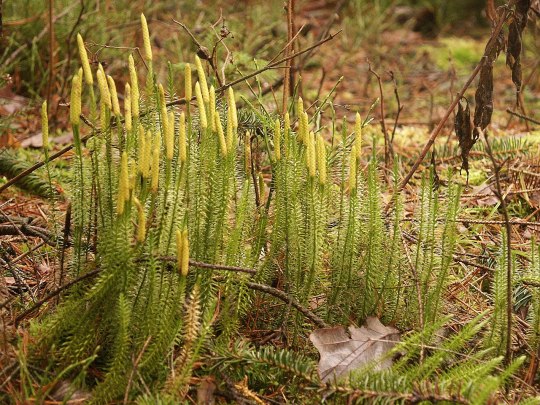
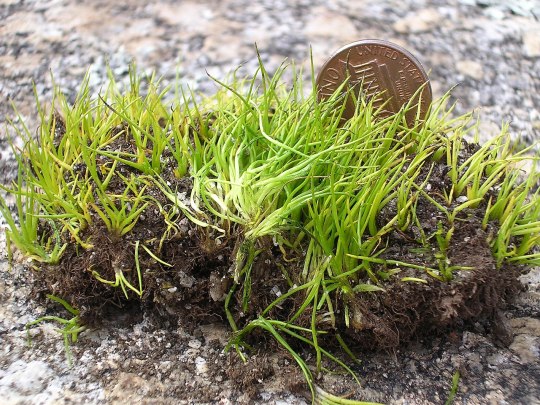
(Lycopodium and Spinulum, modern relatives of Lepidodendron, photos by Bernd Haynold and Pete Pattavina)
You see, Lepidondron lived like a gigantic dandelion. For most of its life, it was a stumpy little thing that stuck close to the ground. Just an odd scaly green stump with some long leaves poking out. The green scales its bark consisted of were the place it conducted its photosynthesis, and thus basically did the work of leaves. The Lepidodendron would stay like this for a couple years, slowly expanding its roots and getting ready for the next step. But its roots would grow mostly horizontally, down not so much! And part of why is that even they had the scaly leaf-like photosynthetic bark. That's right, even their roots could - and to some extend needed to - photosynthesise!

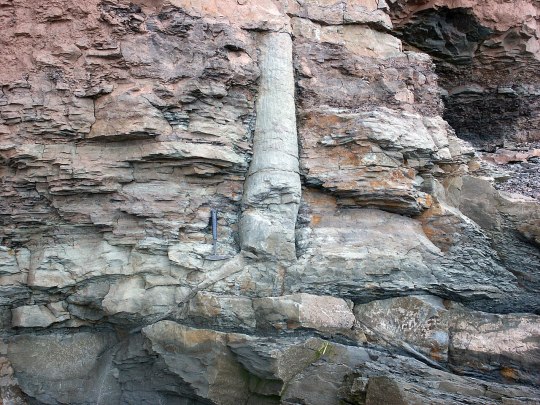
(Fossil Lepidodendron bark in the National Museum of Brazil, photo by Dornicke; a fossilised relative of Lepidodendron with some of its roots visible, photo by Michael C. Rygel)
So why would you ever try to photosynthesise with your roots of all things as a plant? Surely it would make much more sense to just transport the sugars created in other parts there than to have your roots be so shallow that bits of them can catch a little light and make it in situ? Sure, if you're capable of that! This is what modern trees do, but they have two separate vascular tissues they use for transport: xylem, which moves water from the roots to the rest of the plant, and phloem, which moves sugars and other photosynthetic products from the leaves to the rest of the plant. Unfortunately for Lepidodendron, it only had xylem, no phloem, so its sugars were only ever going to move as far as they could diffuse, so every part of the tree needed to have at least a little photosynthesis happening, even the roots.
This truly gets ridiculous when the Lepidodendron decides after a few years of charging up that it's time to reproduce. That's when the weird green stump we have so far starts shooting up, up, up, very quickly, all the way until an enormous 40 or 50 metres in height. Now, modern trees grow this large by being supported by a sturdy wooden core, but that's not what Lepidodendron did. To hold up the entire tree, it relies entirely on its outer bark thickening as it grows. In mechanical terms, it was little more than a huge hollow pole, probably creaking and swaying terribly in the wind. Although I have not been able to confirm this in the literature so far, I suspect that between the shallow roots and the whole thing being held up by its bark, you could probably total a Lepidodendron with a good kick.
Now remember, all this growth is happening without phloem, so the entire length of that stem has to not just be sturdy enough to keep the tree standing, but it also has to keep doing photosynthesis to feed itself. When it reaches its full height, the top of the tree finally starts sprouting branches and small leaves, leaving it looking like the picture at the start. But those are not what it's all about for the tree: the cones that develop among them are. At a height of 50 metres, the spores produced by the cones can very easily be picked up by the wind and blown far, far away. Being spores, rather than seeds as modern trees have, they have no supplies built in whatsoever, so they need to get lucky to land in a spot that has immediate access to water. Luckily, there are a lot of those in the vast Carboniferous swamps, and with the trees doing so much work to spread the spores very widely, some of them are sure to find good spots. And then, with the spores dispersed, the tree is done for. The entire thing, which has just grown to the skies, dies off and soon comes crashing down.
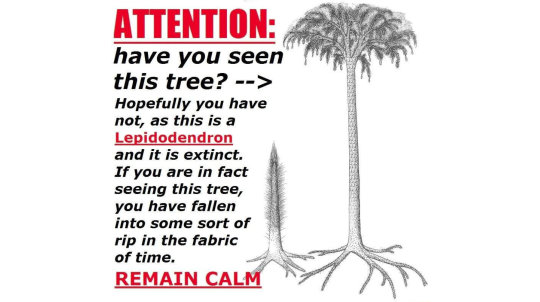
So how weird is this tree? I'd call it a perfect 10.
144 notes
·
View notes
Note
How come the Palaeozoic era has so many weird little dudes?
well, it was the first time life got to try out all of its fucked up little tricks.. and then the permian extinction took them all out :(( life would be so much better if trilobites were still around i think
but fr. it was the first era with recognizable macro-organisms. life was suddenly flourishing and was trying out bunch of stuff. think of it this way: without the paleozoic and its experiments, life as we know it today wouldn’t exist.
so you better thank those godless fish from the devonian for developing jaws and bones ❤️
#i hate the paleozoic bc its plants are somehow boring as fuck#i don’t care about ferns!!!!!!!#or horsetails!!!!!#or lepidodendrons!!!!#talk#ask
57 notes
·
View notes
Text


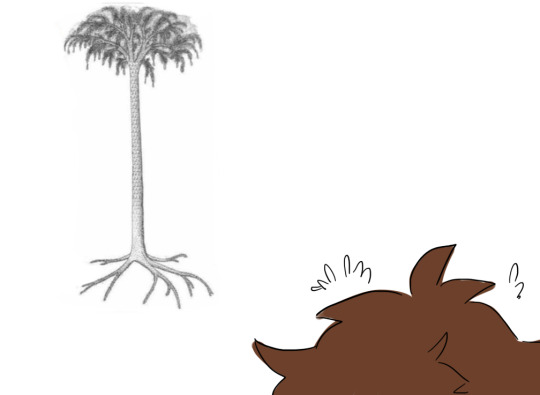
remain calm
#the owl house#toh#toh fanart#alador blight#darius deamonne#toh alador#toh darius#aladarius#darius x alador#remain calm#lepidodendron
160 notes
·
View notes
Text
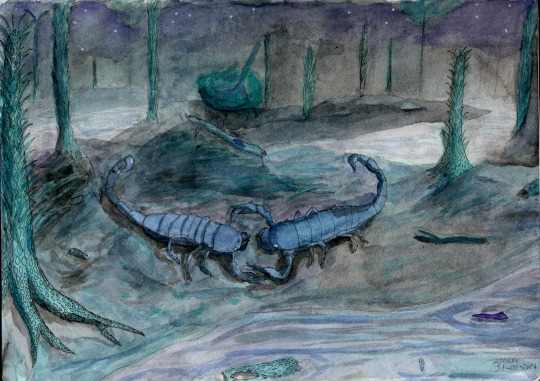
On a moonlit night in the early Carboniferous, two Pulmonoscorpius do a mating dance in the Lepidodendron swamp. Although the giant scorpions have little interest in prey right now, a Balanerpeton amphibian wisely decides to swim away, while several Casineria sleep through the night in the copious tree litter.
#pulmonoscorpius#lepidodendron#balanerpeton#casineria#carboniferous#scorpion#arthropod#cw: bugs#liverwort#amphibian#amniote#paleoart#swamp#my art#palaeoblr#night
53 notes
·
View notes
Text
stupid extinct tree trend thing



#lepidodendron#spiderham#spidernoir#spiderverse#itsv#atsv#spider ham#spider noir#peter porker#8-bitsart#im about to go get burgers :)
141 notes
·
View notes
Text
Funny thing I made




#ena joel g#ena#joel g ena#ena moony#moony joel g#moony ena#joel g fanart#joel guerra#joel g#ena fandom#ena fan art#ena fanart#shitpost#idk what to tag this as#dumb post#idk man#yuh#lepidodendron#trees
96 notes
·
View notes
Text
Time Travel Question 38: Pre-History Continued
These Questions are the result of suggestions from the previous iteration.
This category may include suggestions made too late to fall into the correct earlier time grouping. Basically, I'd already moved on to human history, but I'd periodically get a pre-homin suggestion, hence the occasional random item waaay out of it's time period, rather than reopen the category.
In some cases a culture lasted a really long time and I grouped them by whether it was likely the later or earlier grouping made the most sense with the information I had. (Invention ofs tend to fall in an earlier grouping if it's still open. Ones that imply height of or just before something tend to get grouped later, but not always. Sometimes I'll split two different things from the same culture into different polls because they involve separate research goals or the like).
Please add new suggestions below if you have them for future consideration. All cultures and time periods welcome.
#Time Travel#Friesenhahn Cave#Homotheriums#Mammoth#Megafauna#Pre-History#Ceratopsia#Dinosaurs#Carboniferous#Insects#Evolution#Jellyfish#Sea Creatures#Spinosaur#Hallucigenia#Lepidodendrons#Extinct Plants
60 notes
·
View notes
Text
Wuhoh Larry!! Better high-tail it outta there!!!
#larry johnson#sal fisher#sally face#lepidodendron#extinct tree#lepidodendron meme#sally face strange neighbors#sally face the wretched
71 notes
·
View notes
Text

'Restored aspect of Carboniferous flora' from the Upper Silurian or Passage Beds of Lanarkshire’ from The past and present life of the globe. Being a sketch in outline of the world’s life-system by David Page, 1861
https://archive.org/details/pastpresentlifeo00pagerich/page/104/mode/1up
#carboniferous#palaeobotany#calamites#bothrodendron#equisetites#Asterophyllites#Lepidodendron#caulopteris#sigillaria#lycopodites#pecopteris#past and present life of the globe#david page#1861
11 notes
·
View notes
Text

I drew this way back in november during an aggie.io. Not sure why I found it so funny.
#jon draws occasionally#<- art tag. not commonly seen but is there#the magnus archives fanart#tma art#tma fanart#martin blackwood#martin k blackwood#martin kartin blackwood#the lonely#tma the lonely#the magnus archives#tma#the magnus archives meme#lepidodendron tree meme#the fog i did was so bad uuuuuuuggghh
26 notes
·
View notes
Text
So I finally figured out what that dream I had was about (and what the alter that formed from it is)? And yes the alterhuman tags are relevant i explain why later

Lepidodendron. I had a dream about the extinct lepidodendron "tree" but it was sentient and a deity in a pantheon.
Our mother, our mother told us to never seek ME out, because I would tell us things so upsetting you could die from it..
More under cut
So at first I thought i/he was shaped like a chess peice or tower. But later figured out thru seeing trees without leaves in the pitch dark that I resemble a tree. So I thought, hey these remind me of the monument mythos analog horror series's special trees. But it didn't connect.
Today we were browsing tiktok and came across the myth about the rip in space time and lepidodendron.
The myth says that if you see the tree you either died or entered a difference place in time cause it's extinct. Lepidodendron also isn't actually a tree it just resembles one, it is a plant though! (I think correct me if im wrong)
Obviously the dream strays from the internet trend a bit
So, I almost instantly made the connection. After months of trying to understand that dream, I have figured it out. I know who this headmate is, and what his/my kintypes are.
So hi im Rook but that's just a nickname I was given, and this was also co written by Vesper (He/Him) which is why we keep referring to ourselves weirdly.
And I am a Extinct Phytanthrope (plantkin) who also happens to be a long forgotten Deity and internet trend cryptid.
#alterhuman art#plural art#cryptidkin#lepidodendron kin#lepidodendron#Phytanthrope#plantkin#deitykin#i literally finally cracked the code im losing my mind im not joking#nonhuman#alterhuman
3 notes
·
View notes
Text

2 notes
·
View notes
Text
Pheonix would get caught in a tear in the fabric in time I think



19 notes
·
View notes
Text

A doodle I'm proud of
#art#artists on tumblr#drawing#tumblr draw#digital drawing#doodle#lepidodendron#have you seen this tree
6 notes
·
View notes